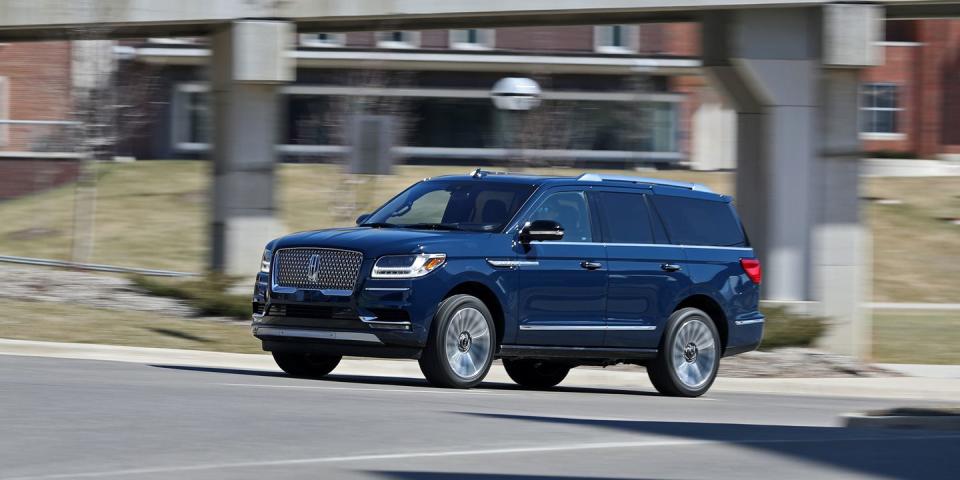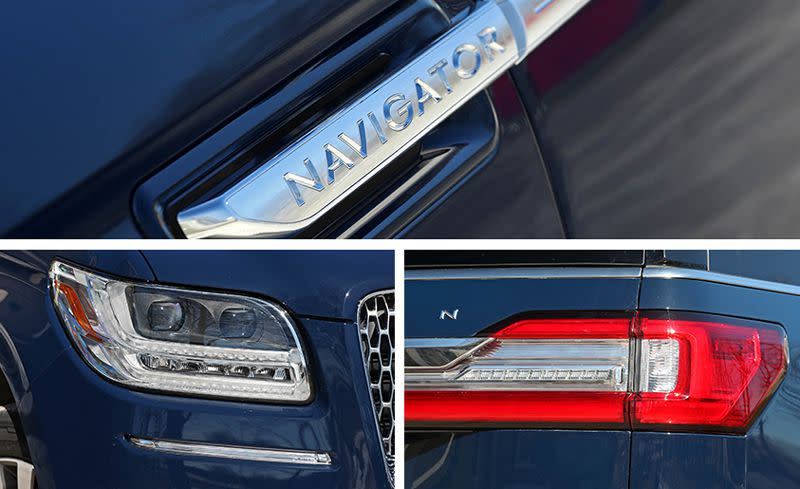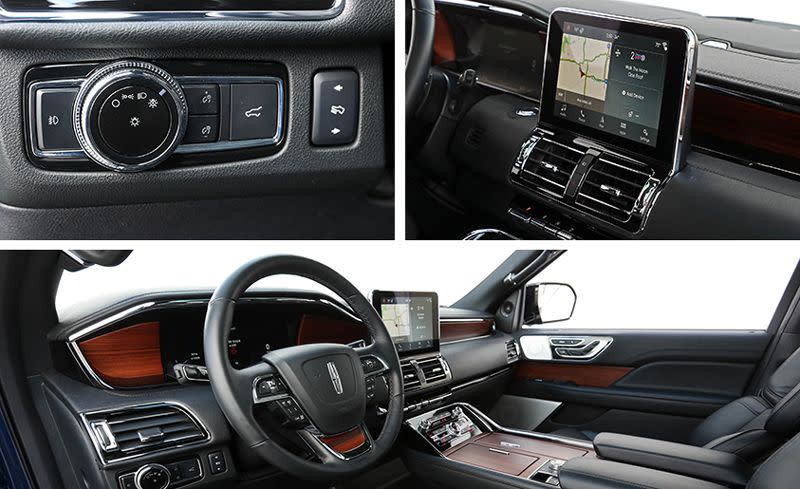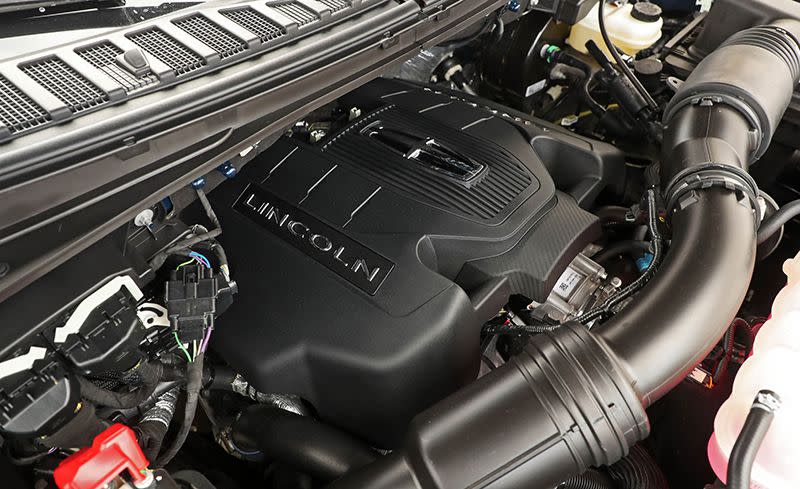2018 Lincoln Navigator 4x4

To fully comprehend the Lincoln Navigator, one must first abandon any altruistic preconceptions. Imposing on the outside and sybaritic on the inside, it takes the “gaud-is-good” formula of the personal-luxury land yachts from half a century ago and updates it for the SUV era. It’s all about YOU, baby-and six of your special friends. Any criticisms leveled by the self-righteous hoi polloi won’t penetrate the exterior, as even at 70 mph our Navigator registered a chapel-like 66 decibels, one decibel quieter than the Cadillac Escalade. Once you come to terms with that, it’s rather easy to embrace the Navigator’s gilded posturing and delight in its opulent interior. Did we mention it also packs the same 450-hp, twin-turbocharged 3.5-liter EcoBoost V-6 as the very capable Ford F-150 Raptor? It does, which means it hauls ass for a three-ton SUV.
For even deeper coverage of the Lincoln Navigator, view our Buyer’s Guide in-depth review.
Second only to the top-rung Navigator Black Label, our Reserve test vehicle comes with all-wheel drive and slots in above the Select trim and the entry-level Premiere model, a.k.a. the Lincoln Navigator hedonism starter pack. (Rear-wheel-drive Navigators come only in Premiere and Select.) While the Black Label trim provides a few extra features, the Reserve is hardly poverty stricken. To that, our test example’s option sheet reveals just four additional, well-curated items: a coat of Burgundy Velvet Metallic paint for $695, a $995 Revel audio system with 20 speakers in place of the Reserve’s standard 16, $225 for a single-disc CD player (remember those?), and finally the sublime Perfect Position front seats for the bargain price of $1250. All in, the $3165 in options barely registered on our Navigator’s as-tested price of $86,165.
Moods for Moderns
Elaborating on a theme Lincoln started with the Continental, the Navigator’s interior leans heavily on the midcentury-modern aesthetic. Rendered in a blend of chrome, leather, and wood veneer, it tries hard to conjure the aura of a Mad Men–era executive office but doesn’t quite make it. It does look handsome, though, and avoids falling prey to Austin Powers–style camp.
Gear selection comes by way of a row of horizontally arranged chrome buttons that run along a flat lower-dash panel above the sizable console; combined with the climate controls and radio buttons it suggests the ergonomics of a vintage Hi-Fi console. The Perfect Position front seats play their part in the illusion by offering a modern interpretation of the iconic Eames office chair. As with the original, spending a few minutes to fine-tune the seating pays huge dividends in the comfort department. A high level of articulation allows occupants to achieve support around the lower back and side bolsters without crowding the shoulders. No one appreciates a comfortable place to sit more than husky Americans, and these seats don’t disappoint. There’s nothing retro about the 10-inch touchscreen that resides atop the center stack, however. Featuring hi-res graphics and a splash screen that could be mistaken for the intro of a summer blockbuster movie, its elegant graphics permit easy menu navigation.
The Navigator’s dynamic attributes also stir tinges of nostalgia, not all of them commendable. The steering is preternaturally light and devoid of feel, which probably will appeal to certain buyers. The ride is soft and compliant on smooth to mildly broken pavement, thanks in part to its independent rear suspension, but it gets a small case of the shudders over bigger bumps. Harsh impacts echo once or twice through the cabin before their memory fades. The quick fix is to select the Excite driving mode, one of the six available. The others are Deep Conditions, Slippery, Slow Climb, Normal, and Conserve. These may seem self-explanatory, but the infotainment screen explains them anyway, nothing that Excite provides “engaging and responsive performance.” While that may be a bit of stretch, it does quicken shifts, adjust throttle mapping, and tighten up the suspension enough to reel in some of the jounce while barely increasing harshness. We found it best to think of Excite mode as normal and Normal as “soft but weak kneed.” Pushed on our 300-foot skidpad, the Navigator posted 0.81 g of grip; while that may seem unremarkable, consider that the last short-wheelbase Escalade we tested managed only 0.73 g and a similarly suspended 2018 Ford Expedition generated 0.79 g. By that measure, the Lincoln is practically a track rat.
Fast Flash
Acceleration is equally impressive, with our Navigator completing the zero-to-60-mph run in just 5.4 seconds and finishing the quarter-mile dash in 14 seconds flat with a trap speed of 100 mph. The badge says Lincoln, but there’s no hiding the accelerative rush of the EcoBoost twin-turbo V-6 paired with a 10-speed automatic that we’ve come to love in the Ford F-150 Raptor-and, new for 2019, in the F-150 Limited. (A 400-hp version of the powertrain powers the similar but less luxe Ford Expedition.) The Cadillac Escalade and GMC Yukon Denali, both with a 6.2-liter V-8, posted slightly slower 5.8- and 14.3-second times in the same tests, while the 2018 Mercedes-Benz GLS450 came close with 5.7- and 14.2-second times. Heck, even the performance-oriented Chevrolet Tahoe RST needed 5.7 seconds to 60 mph and 14.1 in the quarter-mile.
The downside to the Lincoln’s winning acceleration is-no surprise-a powerful thirst. We saw just 13 mpg overall, 5 mpg short of its 18-mpg EPA combined estimate. While no full-boat SUV can be considered a fuel miser, even the Escalade managed 15 mpg in our care. The Navigator did hit 18 mpg in our 75-mph highway test, but the Escalade achieved 21 mpg and the GLS450 turned in a remarkable 25 mpg in the same test.
Slowing the Lincoln’s three tons of midcentury mass is formidable task, requiring 184 feet to stop from 70 mph. More concerning is the soft and nonlinear action of the brake pedal. While you can’t count on it to be precise, you can at least learn to expect its irregular response. Despite the pedal’s indifference, the Navigator clipped a full 18 feet from the 202-foot stopping distance of the Escalade. It also bested the 192-foot measurement posted by the GMC Yukon, the 196-foot figure of the Expedition, and the 186-foot distance of the GLS450. The Nissan Armada is the only big SUV that stopped shorter, in 182 feet.
Fuel economy aside, the Lincoln Navigator manages to make its mark in a well-stocked segment. Lincoln knew it had to blaze its own chrome-and-leather-lined path to make any noise with consumers, and in that respect it succeeds unequivocally. And in terms of acceleration, it’s truly at the top of the class-for now. Just don’t expect to impress your friends from the Sierra Club. Then again, if worrying about the neighbors’ fretting was a concern, you probably wouldn’t be shopping for a three-ton luxury vehicle with an oversized chrome grille and a twin-turbo 450-hp engine.
('You Might Also Like',)

 Yahoo Autos
Yahoo Autos 


